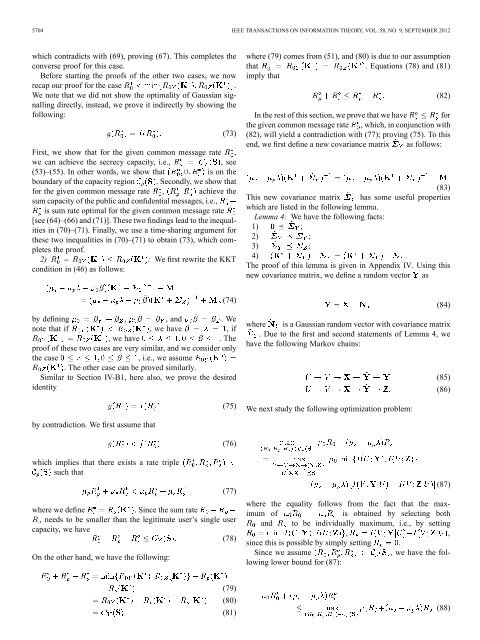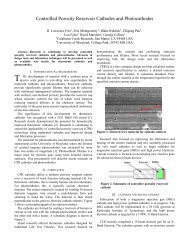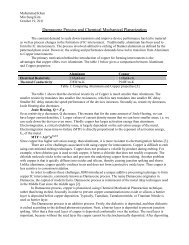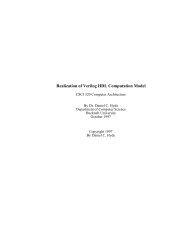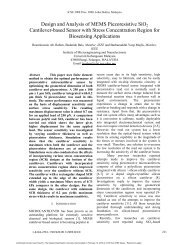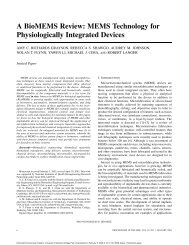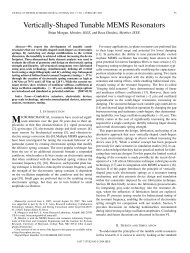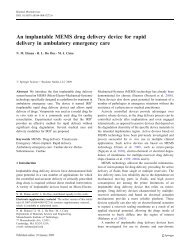Capacity-Equivocation Region of the Gaussian MIMO Wiretap ...
Capacity-Equivocation Region of the Gaussian MIMO Wiretap ...
Capacity-Equivocation Region of the Gaussian MIMO Wiretap ...
Create successful ePaper yourself
Turn your PDF publications into a flip-book with our unique Google optimized e-Paper software.
5704 IEEE TRANSACTIONS ON INFORMATION THEORY, VOL. 58, NO. 9, SEPTEMBER 2012<br />
which contradicts with (69), proving (67). This completes <strong>the</strong><br />
converse pro<strong>of</strong> for this case.<br />
Before starting <strong>the</strong> pro<strong>of</strong>s <strong>of</strong> <strong>the</strong> o<strong>the</strong>r two cases, we now<br />
recap our pro<strong>of</strong> for <strong>the</strong> case .<br />
We note that we did not show <strong>the</strong> optimality <strong>of</strong> <strong>Gaussian</strong> signalling<br />
directly, instead, we prove it indirectly by showing <strong>the</strong><br />
following:<br />
(73)<br />
First, we show that for <strong>the</strong> given common message rate ,<br />
we can achieve <strong>the</strong> secrecy capacity, i.e., ,see<br />
(53)–(55). In o<strong>the</strong>r words, we show that is on <strong>the</strong><br />
boundary <strong>of</strong> <strong>the</strong> capacity region . Secondly, we show that<br />
for <strong>the</strong> given common message rate , achieve <strong>the</strong><br />
sum capacity <strong>of</strong> <strong>the</strong> public and confidential messages, i.e.,<br />
is sum rate optimal for <strong>the</strong> given common message rate<br />
[see (64)–(66) and (71)]. These two findings lead to <strong>the</strong> inequalities<br />
in (70)–(71). Finally, we use a time-sharing argument for<br />
<strong>the</strong>se two inequalities in (70)–(71) to obtain (73), which completes<br />
<strong>the</strong> pro<strong>of</strong>.<br />
2) : We first rewrite <strong>the</strong> KKT<br />
condition in (46) as follows:<br />
(74)<br />
by defining , ,and .We<br />
note that if ,wehave ,if<br />
,wehave .The<br />
pro<strong>of</strong> <strong>of</strong> <strong>the</strong>se two cases are very similar, and we consider only<br />
<strong>the</strong> case , i.e., we assume<br />
. The o<strong>the</strong>r case can be proved similarly.<br />
Similar to Section IV-B1, here also, we prove <strong>the</strong> desired<br />
identity<br />
by contradiction. We first assume that<br />
which implies that <strong>the</strong>re exists a rate triple<br />
such that<br />
(75)<br />
(76)<br />
(77)<br />
wherewedefine . Since <strong>the</strong> sum rate<br />
needs to be smaller than <strong>the</strong> legitimate user’s single user<br />
capacity, we have<br />
(78)<br />
On<strong>the</strong>o<strong>the</strong>rhand,wehave<strong>the</strong>following:<br />
(79)<br />
(80)<br />
(81)<br />
where (79) comes from (51), and (80) is due to our assumption<br />
that . Equations (78) and (81)<br />
imply that<br />
(82)<br />
In <strong>the</strong> rest <strong>of</strong> this section, we prove that we have for<br />
<strong>the</strong> given common message rate , which, in conjunction with<br />
(82), will yield a contradiction with (77); proving (75). To this<br />
end, we first define a new covariance matrix as follows:<br />
(83)<br />
This new covariance matrix has some useful properties<br />
which are listed in <strong>the</strong> following lemma.<br />
Lemma 4: We have <strong>the</strong> following facts:<br />
1) ;<br />
2) ;<br />
3) ;<br />
4) .<br />
The pro<strong>of</strong> <strong>of</strong> this lemma is given in Appendix IV. Using this<br />
new covariance matrix, we define a random vector as<br />
(84)<br />
where is a <strong>Gaussian</strong> random vector with covariance matrix<br />
. Due to <strong>the</strong> first and second statements <strong>of</strong> Lemma 4, we<br />
have <strong>the</strong> following Markov chains:<br />
We next study <strong>the</strong> following optimization problem:<br />
(85)<br />
(86)<br />
(87)<br />
where <strong>the</strong> equality follows from <strong>the</strong> fact that <strong>the</strong> maximum<br />
<strong>of</strong> is obtained by selecting both<br />
and to be individually maximum, i.e., by setting<br />
, ,<br />
since this is possible by simply setting .<br />
Sinceweassume ,wehave<strong>the</strong>following<br />
lower bound for (87):<br />
(88)


